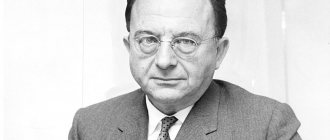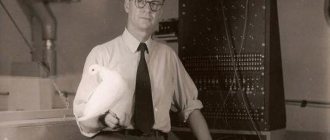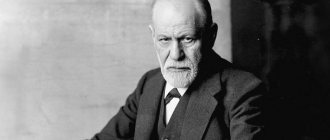Biography
Erich Fromm is an American psychoanalyst with German roots who developed the concept of humanistic psychoanalysis. A prominent representative of the Frankfurt School, one of the founders of neo-Freudianism and Freudo-Marxism.
Portraits of Erich Fromm
Many books by the personality psychology theorist, written in living language, became bestsellers: “Escape from Freedom”, “Man for Himself”, “To Have or to Be”, “The Art of Loving”.
The main theme of the work of Erich Fromm, who devoted almost his entire life to the study of the subconscious, was the contradictions of human existence in the world.
Humanistic credo
In an addendum to his book The Human Soul: Its Capacity for Good and Evil, Fromm wrote part of his famous humanistic credo. In his opinion, a person who chooses progress can find a new unity through the development of all his human powers, which is carried out in three directions. They can be presented separately or together as love of life, humanity and nature, as well as independence and freedom.
Childhood and youth
The future psychoanalyst was born in Frankfurt am Main in 1900. Erich is the only child in an Orthodox Jewish family. Naftali Fromm, the head of the family, owned a wine shop. Erich's mother, Rosa Krause, is the daughter of emigrants from Poznan (then Prussia). Religious traditions were maintained in the family, and the parents dreamed of seeing their son become a rabbi or, at worst, a musician.
Erich studied at a school where the basics of Judaism and general education subjects were taught. In 1918, Fromm graduated from school and became a student at Heidelberg University. At the university, Erich chose philosophy, sociology and psychology as his priority subjects.
Erich Fromm in his youth and adulthood
In 1922, Erich Fromm defended his doctoral dissertation, choosing the topic of Jewish law and the sociology of the Jewish Diaspora. Alfred Weber, the younger brother of the world-famous historian and economist Max Weber, became his supervisor.
Fromm continued his education in Berlin, at the Institute of Psychoanalysis, famous for its students and teachers Sandor Rado, Max Eitingon, Wilhelm Reich.
In Berlin, Erich Fromm met his future lover Karen Horney, a psychoanalyst, graduate of the institute and a key figure in neo-Freudianism. The influential Horney helped Fromm secure a position as a professor of psychology in Chicago.
Life in America
After moving to Mexico City in 1950, Fromm became a professor at the National Academy of Mexico and created the psychoanalytic sector of the medical school. He taught there until his retirement in 1965. Fromm was also a professor of psychology at Michigan State University from 1957 to 1961 and an adjunct professor of psychology in the Graduate School of Arts and Sciences at New York University.
Fromm changes his preferences again. A strong opponent of the Vietnam War, he supports pacifist movements in the United States.
In 1965, he ended his teaching career, but for several more years he lectured at various universities, institutes and other institutions.
Philosophy
In the mid-1920s, Erich Fromm became a psychoanalyst and opened a private practice, which he did not stop for 35 years. Communication with patients provided rich material for the analysis of biological and social factors in the formation of the human psyche.
Psychoanalyst Erich Fromm
In Frankfurt, working at the Institute for Social Research from 1929 to 1932, Fromm interpreted and classified his observations. During these years, he wrote and published his first works on the methods and tasks of psychology.
In 1933, when Adolf Hitler came to power, the scientist moved to Switzerland, and a year later to America. In New York, Fromm was taken to Columbia University, entrusted with teaching psychology and sociology. In the early 1940s, the German scientist was at the forefront of the formation of the Washington School of Psychiatry, and in 1946 he became the founder of the William Alanson White Institute of Psychiatry.
Erich Fromm at work
In 1950, the psychoanalyst moved to the capital of Mexico and worked for 15 years as a teacher at the National Autonomous University, the largest in the Americas. Erich Fromm studied social projects of different eras and published the work “A Healthy Society,” in which he criticized the capitalist system.
In 1960, the scientist became a member of the American Socialist Party and even wrote the program principles, which the party members rejected after much debate. Erich Fromm gave lectures to students, wrote scientific works and participated in rallies. The eminent psychoanalyst and sociologist was invited to the universities of New York and Michigan.
Fromm's works were extremely popular. The book “Escape from Freedom,” published in the early 1940s, became a bestseller. The scientist studied changes in the psyche and behavior of a person in Western culture, examined how his desire for individuality leads to loneliness. In his work, Fromm paid special attention to the period of the Reformation and the teachings of theologians John Calvin and Martin Luther.
In 1947, the scientist wrote a continuation of the popular study on flight from freedom, calling it “Man for Himself,” in which he developed a theory of human self-isolation in the world of Western values and culture. Erich Fromm saw the cause of neuroses in the moral defeat of a person in the struggle for freedom, and called the task of psychoanalysis the disclosure by an individual of the truth about himself.
John Calvin and Martin Luther
In the mid-1950s, the founder of humanistic psychoanalysis published the book “Healthy Society,” in which he raised the topic of the relationship between society and man. In this work, Erich Fromm tried to “reconcile” the opposing theories of Sigmund Freud and Karl Marx. The first believed that man is antisocial by nature, the second - that the individual is a “social animal.” The book became a bestseller, which was disassembled into quotes. One of them:
“In the 19th century. the problem was that God was dead; in XX – that a person is dead.”
Studying human psychology and behavior in different strata of societies and countries, the psychoanalyst came to the conclusion that the least suicides occur in the poorest countries. And Fromm called cinema, radio, television, and public events “ways of escape” from nervous disorders, and if these “benefits” are taken away from the people of Western civilization for 4 weeks, then many thousands will be diagnosed with neurosis.
Books by Erich Fromm
In the mid-1960s, Fromm presented fans with a new work called “The Soul of Man.” In the book, the German psychologist focused on the essence of evil. In a certain sense, this work became a continuation of another, called “The Art of Loving.” Discussing the nature of evil, Erich Fromm concluded that violence is a product of the desire to rule, and it is not so much sadists and monsters who are dangerous as ordinary people who have concentrated power in their hands.
In the 1970s, Erich Fromm, continuing to analyze the most pressing problems of the era, published the work “The Anatomy of Human Destructiveness,” in which he developed the theme of the nature of human self-destruction.
Links to the Talmud
Fromm often illustrated his main ideas with examples from the Talmud, but his interpretation is far from traditional. He used the story of Adam and Eve as an allegorical explanation of human biological evolution and existential angst, arguing that when Adam and Eve ate from the “tree of knowledge,” they realized that they were separate from nature while still being part of it. Adding a Marxist perspective to the story, he interpreted Adam and Eve's disobedience as justifiable rebellion against an authoritarian God. Man's destiny, according to Fromm, cannot depend on any participation of the Almighty or any other supernatural source, but only through his own efforts can he take responsibility for his life. In another example, he mentions the story of Jonah, who was unwilling to save the people of Nineveh from the consequences of their sin, as evidence of the belief that most human relationships lack care and responsibility.
Personal life
Erich Fromm explained his love for older women as a lack of maternal warmth in childhood. The first wife of the 26-year-old scientist was his 10-year-older colleague Frieda Reichmann, from whom the young scientist took a lecture course in psychoanalysis.
Frieda Reichmann, first wife of Erich Fromm
Fromm lived with Frida for only 4 years, but the woman influenced the professional development of her husband. After the separation, they remained friends, and officially divorced in 1940, when Erich met Karen Horney.
Karen Horney, common-law wife of Erich Fromm
The famous feminist and psychoanalyst Horney often entered into romantic relationships with colleagues, invariably being disappointed in her chosen ones. Sometimes Karen had several lovers at the same time, each of them complementing the missing qualities of the others.
Karen and Erich met in Berlin. The romance broke out in America, where they immigrated. Horney taught Fromm the techniques of psychoanalysis, and he taught her the basics of sociology. The romance did not result in marriage, but the scientists complemented each other’s knowledge and influenced further professional growth.
Henny Gurland, second wife of Erich Fromm
Fromm officially married for the second time at the age of 40. His wife was 10 years older Henny Gurland, a photographer and journalist. Henny had a serious back problem. To alleviate his wife’s suffering, Fromm, on the advice of doctors, moved to Mexico City. The death of his beloved in 1952 shocked the scientist. While living with Gurland, the German psychoanalyst became interested in mysticism and Zen Buddhism.
Erich was able to cope with depression by meeting Annis Freeman. She became Fromm's only woman who was younger than him.
The couple lived together for 27 years, until the scientist’s death. American Annis inspired her husband to write the scientific bestseller “The Art of Loving.”
Love concept
Fromm separated his concept of love from popular concepts to such an extent that his reference to it became almost paradoxical. He considered love to be an interpersonal, creative capacity rather than an emotion, and he distinguished this creativity from what he saw as the various forms of narcissistic neuroses and sadomasochistic tendencies that are usually cited as evidence of "true love." Indeed, Fromm views the experience of "falling in love" as evidence of an inability to comprehend the true nature of love, which he believed always has elements of care, responsibility, respect and knowledge. He also argued that few people in modern society respect the autonomy of other people, much less objectively know their real needs and needs.
Death
Towards the end of the 1960s, Erich Fromm was diagnosed with his first heart attack. In the mid-1970s, the scientist moved to the Swiss commune of Muralto, where he completed work on the book “To Have and to Be.” In 1977 and 1978, Fromm had his second and third heart attacks.
Erich Fromm in recent years
The famous psychoanalyst's heart stopped in 1980. Erich Fromm did not live 5 days before his 80th birthday.
Participation in politics
Erich Fromm's biography is marked by his periodic active participation in US politics. He joined the US Socialist Party in the mid-1950s and did everything he could to help it represent a viewpoint different from the prevailing "McCarthyism" of the time, which was best expressed in his 1961 article "Can Man Prevail?" A Study of Fact and Fiction in Foreign Policy.” However, Fromm, as a co-founder of SANE, saw his greatest political interest in the international peace movement, the fight against the nuclear arms race and US involvement in the Vietnam War. After Eugene McCarthy's candidacy failed to receive Democratic Party support in the 1968 presidential nomination, Fromm left the American political scene, although in 1974 he wrote an article for hearings held by the US Senate Committee on Foreign Relations entitled " Remarks on the policy of détente."
Bibliography
- 1922 – “The Jewish Law. Toward the sociology of Diaspora Jewry"
- 1941 – “Flight from Freedom”
- 1947 – “A Man for Himself”
- 1949 – “Man and Woman”
- 1950 – “Psychoanalysis and Religion”
- 1951 – “Forgotten language. Introduction to the science of understanding dreams, fairy tales and myths"
- 1955 – “Healthy Society”
- 1956 – “The Art of Loving”
- 1962 – “Beyond the illusions that enslave us. How I Encountered Marx and Freud"
- 1968 – “Human Nature”
- 1970 – “The Crisis of Psychoanalysis”
- 1973 – “The Anatomy of Human Destructiveness”
- 1976 – “To Have or To Be”
- 1979 – “The Greatness and Limitations of Freud’s Theory”
- 1981 – “On Disobedience and Other Essays”
Heritage
Fromm did not leave a noticeable mark in the field of psychoanalysis. His desire to substantiate Freud's theory with empirical data and methods was better succeeded by other psychoanalysts such as Erik Erikson and Anna Freud. Fromm is sometimes cited as the founder of neo-Freudianism, but he had little influence on the movement's followers. His ideas in psychotherapy had success in the field of humanistic approaches, but he criticized Carl Rogers and others to such an extent that he isolated himself from them. Fromm's theories are not usually discussed in personality psychology textbooks.
His influence on humanistic psychology was significant. His work has inspired many social analysts. An example is Christopher Lasch's The Culture of Narcissism, which continues efforts to psychoanalyze culture and society in the neo-Freudian and Marxist traditions.
His sociopolitical influence ended with his involvement in American politics in the 1960s and early 1970s.
Nevertheless, Erich Fromm's books are constantly being rediscovered by scholars who are individually influenced by them. In 1985, 15 of them founded the International Society named after him. The number of its members exceeded 650 people. The Society is dedicated to encouraging scientific work and research based on the work of Erich Fromm.








